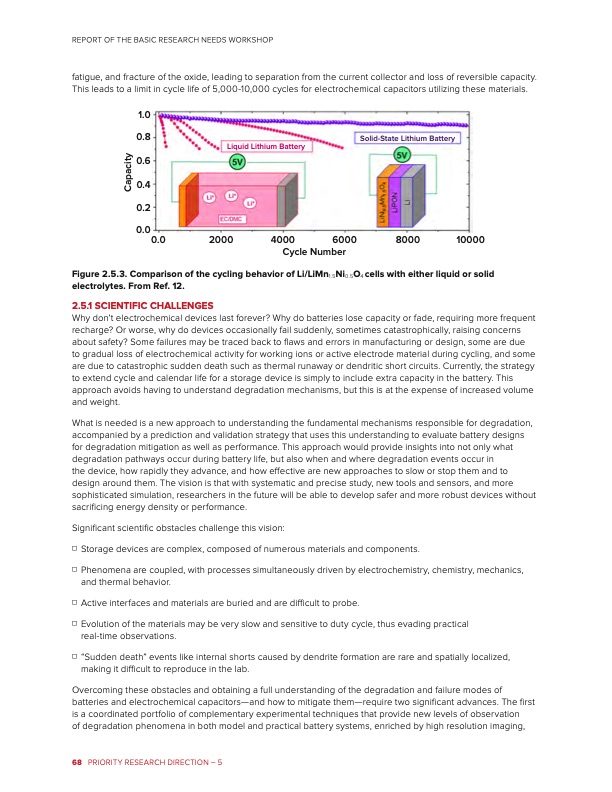
PDF Publication Title:
Text from PDF Page: 074
REPORT OF THE BASIC RESEARCH NEEDS WORKSHOP fatigue, and fracture of the oxide, leading to separation from the current collector and loss of reversible capacity. This leads to a limit in cycle life of 5,000-10,000 cycles for electrochemical capacitors utilizing these materials. 1.0 0.8 0.6 0.4 0.2 0.00.0 Liquid Lithium Battery 2000 4000 Cycle Number Solid-State Lithium Battery 8000 10000 Figure 2.5.3. Comparison of the cycling behavior of Li/LiMn1.5Ni0.5O4 cells with either liquid or solid electrolytes. From Ref. 12. 2.5.1 SCIENTIFIC CHALLENGES Why don’t electrochemical devices last forever? Why do batteries lose capacity or fade, requiring more frequent recharge? Or worse, why do devices occasionally fail suddenly, sometimes catastrophically, raising concerns about safety? Some failures may be traced back to flaws and errors in manufacturing or design, some are due to gradual loss of electrochemical activity for working ions or active electrode material during cycling, and some are due to catastrophic sudden death such as thermal runaway or dendritic short circuits. Currently, the strategy to extend cycle and calendar life for a storage device is simply to include extra capacity in the battery. This approach avoids having to understand degradation mechanisms, but this is at the expense of increased volume and weight. What is needed is a new approach to understanding the fundamental mechanisms responsible for degradation, accompanied by a prediction and validation strategy that uses this understanding to evaluate battery designs for degradation mitigation as well as performance. This approach would provide insights into not only what degradation pathways occur during battery life, but also when and where degradation events occur in the device, how rapidly they advance, and how effective are new approaches to slow or stop them and to design around them. The vision is that with systematic and precise study, new tools and sensors, and more sophisticated simulation, researchers in the future will be able to develop safer and more robust devices without sacrificing energy density or performance. Significant scientific obstacles challenge this vision: ☐ Storage devices are complex, composed of numerous materials and components. ☐ Phenomena are coupled, with processes simultaneously driven by electrochemistry, chemistry, mechanics, and thermal behavior. ☐ Active interfaces and materials are buried and are difficult to probe. ☐ Evolution of the materials may be very slow and sensitive to duty cycle, thus evading practical real-time observations. ☐ “Sudden death” events like internal shorts caused by dendrite formation are rare and spatially localized, making it difficult to reproduce in the lab. Overcoming these obstacles and obtaining a full understanding of the degradation and failure modes of batteries and electrochemical capacitors—and how to mitigate them—require two significant advances. The first is a coordinated portfolio of complementary experimental techniques that provide new levels of observation of degradation phenomena in both model and practical battery systems, enriched by high resolution imaging, 68 PRIORITY RESEARCH DIRECTION – 5 6000 CapacityPDF Image | Next Generation Electrical Energy Storage

PDF Search Title:
Next Generation Electrical Energy StorageOriginal File Name Searched:
BRN-NGEES_rpt-low-res.pdfDIY PDF Search: Google It | Yahoo | Bing
Sulfur Deposition on Carbon Nanofibers using Supercritical CO2 Sulfur Deposition on Carbon Nanofibers using Supercritical CO2. Gamma sulfur also known as mother of pearl sulfur and nacreous sulfur... More Info
CO2 Organic Rankine Cycle Experimenter Platform The supercritical CO2 phase change system is both a heat pump and organic rankine cycle which can be used for those purposes and as a supercritical extractor for advanced subcritical and supercritical extraction technology. Uses include producing nanoparticles, precious metal CO2 extraction, lithium battery recycling, and other applications... More Info
| CONTACT TEL: 608-238-6001 Email: greg@infinityturbine.com | RSS | AMP |